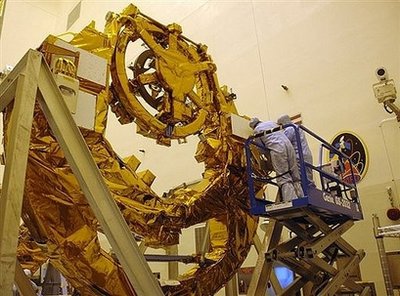CAPE CANAVERAL, Fla. -- NASA will attempt on Wednesday to revive the $2 billion Hubble Space Telescope, which was idled two weeks ago by an equipment failure, officials said on Tuesday.

Technicians make final checks to Hubble servicing equipment in September 2008 in the Payload Hazardous Servicing facility at Kennedy Space Center, Florida. NASA said Tuesday it will make an attempt to revive the space telescope Hubble, idled since september 27 by an equiment failure, officials said on Tuesday. [Agencies]
|
The breakdown of a computer needed to relay science data to Earth prompted NASA to postpone until next year a long-awaited space shuttle mission to upgrade the orbital observatory. That flight, which had been slated for liftoff on Tuesday, was rescheduled for February.
Engineers plan to send commands to the telescope early on Wednesday to switch over to a backup computer that has not even been turned on since before the telescope arrived in orbit 18 years ago.
"It is obviously a possibility that things will not come up," said Art Whipple, the Hubble Space Telescope program manager at NASA's Goddard Space Flight Center in Greenbelt, Maryland.
"There's very little aging that goes on with an unpowered component in space," he said. "It's actually a very benign storage environment."
If the operation is successful, Hubble should be conducting scientific work again by Friday, Whipple said.
By delaying the shuttle mission, NASA hopes to fly a replacement data handling computer to restore backup capability to the telescope. The mission is to be the fifth and final servicing call by space shuttle astronauts to the observatory.
The shuttle program is scheduled to end in two years.
Hubble managers said they should know by early November if the spare unit is in good condition to fly.
Hubble has changed scientists' understanding of the origin, evolution and contents of the universe and delivered unprecedented images of distant galaxies and celestial phenomena to people worldwide.
Shuttle astronauts plan to install two new science instruments, fix two failed cameras, and replace the telescope's batteries and gyroscopes, among other tasks.
The telescope orbits about 300 miles (485 km) above the planet.

